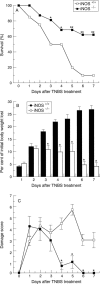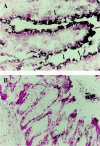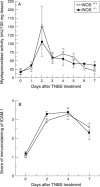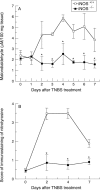Reduced oxidative and nitrosative damage in murine experimental colitis in the absence of inducible nitric oxide synthase
- PMID: 10403731
- PMCID: PMC1727621
- DOI: 10.1136/gut.45.2.199
Reduced oxidative and nitrosative damage in murine experimental colitis in the absence of inducible nitric oxide synthase
Abstract
Background: Oxidative and nitrosative stress have been implicated in the pathogenesis of inflammatory bowel diseases.
Aims: To study the role of nitric oxide (NO) derived from inducible NO synthase (iNOS) in an experimental model of murine enterocolitis.
Methods: Trinitrobenzene sulphonic acid (TNBS) was instilled per rectum to induce a lethal colitis in iNOS deficient mice and in wild type controls. The distal colon was evaluated for histological evidence of inflammation, iNOS expression and activity, tyrosine nitration and malondialdehyde formation (as indexes of nitrosative and oxidative stress), myeloperoxidase activity (as index of neutrophil infiltration), and tissue localisation of intercellular adhesion molecule 1 (ICAM-1).
Results: TNBS administration induced a high mortality and weight loss associated with a severe colonic mucosal erosion and ulceration, increased myeloperoxidase activity, increased concentrations of malondialdehyde, and an intense staining for nitrotyrosine and ICAM-1 in wild type mice. Genetic ablation of iNOS gene conferred to mice a significant resistance to TNBS induced lethality and colonic damage, and notably reduced nitrotyrosine formation and concentrations of malondialdehyde; it did not, however, affect neutrophil infiltration and intestinal ICAM-1 expression in the injured tissue.
Conclusion: Data show that activation of iNOS is required for nitrosative and oxidative damage in experimental colitis.
Figures








Similar articles
-
Melatonin reduces dinitrobenzene sulfonic acid-induced colitis.J Pineal Res. 2001 Jan;30(1):1-12. doi: 10.1034/j.1600-079x.2001.300101.x. J Pineal Res. 2001. PMID: 11168901
-
Blockade of Poly(ADP-ribose) synthetase inhibits neutrophil recruitment, oxidant generation, and mucosal injury in murine colitis.Gastroenterology. 1999 Feb;116(2):335-45. doi: 10.1016/s0016-5085(99)70130-7. Gastroenterology. 1999. PMID: 9922314
-
Mercaptoethylguanidine, a combined inhibitor of nitric oxide synthase and peroxynitrite scavenger, reduces trinitrobenzene sulfonic acid-induced colonic damage in rats.J Pharmacol Exp Ther. 1998 Dec;287(3):1048-55. J Pharmacol Exp Ther. 1998. PMID: 9864291
-
Nitric oxide in inflammatory bowel disease.Inflamm Bowel Dis. 2003 May;9(3):179-89. doi: 10.1097/00054725-200305000-00006. Inflamm Bowel Dis. 2003. PMID: 12792224 Review.
-
Nitric oxide and chronic gut inflammation: controversies in inflammatory bowel disease.J Investig Med. 2002 Jul;50(4):272-83. doi: 10.2310/6650.2002.33281. J Investig Med. 2002. PMID: 12109591 Review.
Cited by
-
Nitric oxide-induced cellular stress and p53 activation in chronic inflammation.Proc Natl Acad Sci U S A. 2003 Jan 7;100(1):143-8. doi: 10.1073/pnas.0237083100. Epub 2002 Dec 23. Proc Natl Acad Sci U S A. 2003. PMID: 12518062 Free PMC article.
-
The cyclopentenone prostaglandin 15-deoxy-delta(12,14)- PGJ2 attenuates the development of colon injury caused by dinitrobenzene sulphonic acid in the rat.Br J Pharmacol. 2003 Feb;138(4):678-88. doi: 10.1038/sj.bjp.0705077. Br J Pharmacol. 2003. PMID: 12598422 Free PMC article.
-
Intestinal myofibroblasts produce nitric oxide in response to combinatorial cytokine stimulation.J Cell Physiol. 2013 Mar;228(3):572-80. doi: 10.1002/jcp.24164. J Cell Physiol. 2013. PMID: 22833357 Free PMC article.
-
Expression of nitric oxide synthases and effects of L-arginine and L-NMMA on nitric oxide production and fluid transport in collagenous colitis.Gut. 2001 Sep;49(3):387-94. doi: 10.1136/gut.49.3.387. Gut. 2001. PMID: 11511561 Free PMC article.
-
Calpain inhibitor I reduces colon injury caused by dinitrobenzene sulphonic acid in the rat.Gut. 2001 Apr;48(4):478-88. doi: 10.1136/gut.48.4.478. Gut. 2001. PMID: 11247891 Free PMC article.
References
MeSH terms
Substances
LinkOut - more resources
Full Text Sources
Other Literature Sources
Medical
Molecular Biology Databases
Research Materials
Miscellaneous
